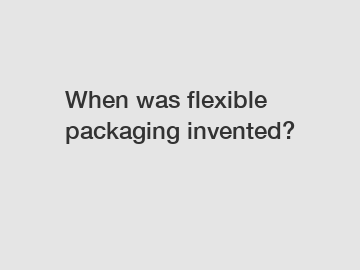When was flexible packaging invented?
When was flexible packaging invented?
Flexible packaging has become an indispensable part of our daily lives. From protecting our food to keeping our household products secure, flexible packaging offers convenience, preservation, and cost-saving benefits. But have you ever wondered when this innovative packaging solution was first introduced? In this article, we will delve into the origins and evolution of flexible packaging, exploring its impact on various industries and the environment.
1. Origins of flexible packaging:

Flexible packaging as we know it today has its roots in the early 20th century. The invention of cellophane in 1908 by Swiss chemist Jacques Brandenberger marked a significant step towards the development of flexible packaging. Initially, cellophane was used for simple applications such as wrapping candies and cigarettes. However, its versatile nature paved the way for further advancements in flexible packaging.
2. Evolution and advancements:
In the 1970s, with the emergence of high-speed machinery and improved printing techniques, flexible packaging started to gain popularity across industries. The ability to print vibrant designs and product information directly onto the packaging opened up new possibilities for branding and marketing. Manufacturers could now create visually appealing packaging that caught the consumers' attention.
3. Advantages of flexible packaging:
Flexible packaging offers numerous advantages that contribute to its widespread adoption. Firstly, it is lightweight and flexible, making it easier to handle and transport. Unlike rigid packaging, flexible materials can be easily folded or formed to fit the contours of various products, reducing waste and maximizing space utilization.
Secondly, flexible packaging extends the shelf life of products by providing excellent barrier properties. It protects against moisture, oxygen, and light, preserving the freshness and quality of perishable goods. This not only reduces food waste but also ensures that consumers receive products in optimal condition.
Moreover, flexible packaging often requires fewer raw materials compared to rigid alternatives, making it a sustainable choice. It results in reduced energy consumption during production, lower transportation costs, and less waste generation. Additionally, advancements in recycling technology have made it possible to recycle certain types of flexible packaging, further reducing its environmental impact.
4. Application in various industries:
Flexible packaging is widely used across multiple industries, including food and beverages, pharmaceuticals, personal care, and household products. In the food industry, flexible packaging plays a crucial role in preserving flavor, nutritional value, and freshness. From snack pouches to stand-up pouches for liquid products, it provides convenience and extends the shelf life of various food items.
Similarly, in the pharmaceutical industry, flexible packaging ensures the integrity of medical products and ensures proper dosage administration. The ability to create tamper-evident and child-resistant features enhances safety and security.
Flexible packaging has also made its mark in the personal care industry. From squeezable tubes for cosmetics to resealable pouches for toiletries, it provides user-friendly packaging solutions that are convenient for both manufacturers and consumers.
5. Environmental considerations:
While flexible packaging offers numerous advantages, it is essential to address its impact on the environment. The flexible nature and complex multilayer structure of some packaging materials make them less recyclable. This poses challenges for recycling facilities and raises questions about the disposal of certain types of flexible packaging.
However, the industry has recognized these concerns and is actively working towards more sustainable solutions. Manufacturers are exploring innovative methods to improve recyclability and reduce the environmental footprint of flexible packaging. Initiatives such as the development of mono-material packaging aim to simplify recycling processes and create more sustainable options for consumers.
In conclusion, flexible packaging has come a long way since its inception in the early 20th century. The continuous advancements in technology and materials have transformed the packaging landscape, offering convenience, preservation, and cost-saving benefits across industries. While environmental challenges remain, the industry is actively working towards sustainable solutions. As we move forward, it is vital to strike a balance between innovation and environmental responsibility, ensuring that flexible packaging remains an efficient and eco-friendly choice for the future.
Want more information on horizontal form fill seal machines, high speed packaging machine solution, flexible packaging machinery manufacturers? Feel free to contact us.


